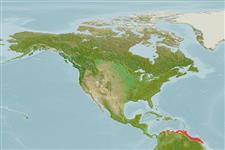Teleostei (teleosts) >
Eupercaria/misc (Various families in series Eupercaria) >
Haemulidae (Grunts) > Haemulinae
Etymology: Haemulon: Greek, haimaleos = bloody (Ref. 45335).
Eponymy: Professor Dr Hilbrand Boschma (1893–1976) was a Dutch zoologist, herpetologist, and expert on crustaceans. [...] (Ref. 128868), visit book page.
Environment: milieu / climate zone / depth range / distribution range
Ecology
Marine; reef-associated; depth range 0 - 100 m (Ref. 3798). Tropical; 22°N - 4°N, 98°W - 50°W
Western Atlantic: Colombia to French Guiana.
Size / Weight / Age
Maturity: Lm ? range ? - ? cm
Max length : 19.0 cm TL male/unsexed; (Ref. 9626); common length : 15.0 cm TL male/unsexed; (Ref. 3798)
Dorsal spines (total): 13 - 14; Dorsal soft rays (total): 13; Anal spines: 3; Anal soft rays: 8 - 9. Head scaled except for tip of snout and chin; mouth small and oblique; yellowish to greenish silver on back, silvery on sides, with 4 brown to bronze stripes on upper half of body and a large black spot at caudal base (Ref. 13442).
Generally in protected areas such as bays or inlets; rarely in insular areas with clear oceanic water and coral reefs (Ref. 5217). Juveniles encountered near the shore. Feeds on small crustaceans and mollusks (Ref. 3798). Taken incidentally and not considered commercially important (Ref. 3798).
Life cycle and mating behavior
Maturity | Reproduction | Spawning | Eggs | Fecundity | Larvae
Distinct pairing during breeding (Ref. 205).
Cervigón, F., 1993. Los peces marinos de Venezuela. Volume 2. Fundación Científica Los Roques, Caracas,Venezuela. 497 p. (Ref. 9626)
IUCN Red List Status (Ref. 130435: Version 2024-1)
Threat to humans
Harmless
Human uses
Fisheries: commercial; bait: occasionally
Tools
Special reports
Download XML
Internet sources
Estimates based on models
Preferred temperature (Ref.
123201): 25.4 - 28.2, mean 27.2 °C (based on 138 cells).
Phylogenetic diversity index (Ref.
82804): PD
50 = 0.5000 [Uniqueness, from 0.5 = low to 2.0 = high].
Bayesian length-weight: a=0.01479 (0.00702 - 0.03115), b=2.99 (2.82 - 3.16), in cm total length, based on LWR estimates for this Genus-body shape (Ref.
93245).
Trophic level (Ref.
69278): 3.5 ±0.50 se; based on food items.
Resilience (Ref.
120179): High, minimum population doubling time less than 15 months (Preliminary K or Fecundity.).
Fishing Vulnerability (Ref.
59153): Low vulnerability (10 of 100).
Nutrients (Ref.
124155): Calcium = 65.2 [21.1, 122.1] mg/100g; Iron = 0.686 [0.359, 1.217] mg/100g; Protein = 19.1 [17.3, 20.9] %; Omega3 = 0.167 [0.087, 0.269] g/100g; Selenium = 31.9 [19.1, 54.3] μg/100g; VitaminA = 107 [43, 261] μg/100g; Zinc = 1.39 [0.95, 2.08] mg/100g (wet weight);
